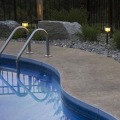The goal of landscape lighting is to see only the effect of light, not the light source itself. The exception is path lighting, which is designed to be decorative and on display. Place accessories no closer than 20 feet apart. You want light groups to guide your eye from one floor to the next, not continuous lighting.
The type of landscape lights you need depends on the desired function and aesthetic appeal. Pathway lights are essential for illuminating walkways, ensuring safety during nighttime. Spotlights can accentuate specific features, such as statues or trees, while floodlights are ideal for broad illumination of larger areas. Ambient lighting, like lanterns or garden lights, can create a warm and inviting atmosphere. When choosing landscape lights, it's crucial to consider both functionality and design. Consulting with professionals specializing in landscaping in Wellington can provide tailored recommendations, ensuring that the lighting solutions not only enhance the beauty of your outdoor spaces but also cater to your specific requirements.
Pathway and walkway lights are the most common type of landscape lighting. They are small poles with built-in light and covered with a diffuser. They can be spaced along a path or they can be used to frame an area or feature of your patio. You can line them up on a walkway, around a pond or outline your driveway.
Deck and step lights are usually installed directly in your garden or terrace. They are often used to accentuate an architectural detail or to add a safe guide dark stairs. You can also use them to wash light on exterior walls or to illuminate entertainment spaces. Achieve this look with spotlights and well lights Achieve this look with spotlights, projectors and well lights.
Achieve this look with projectors Achieve this look with well lights, spotlights and hardscape lights. Deck lights are used to improve safety when going up or down deck stairs at night. They are installed directly on the hard landscape or on the roof itself to accentuate architectural details and illuminate entertainment spaces. Like path lights, pole lights help accentuate a path by illuminating spaces that are lost in the dark.
They are bigger and taller and set an ambient tone without being too bright. Placing spotlights or well lights behind an object or plant can highlight dramatic shapes that aren't as noticeable during the day. The light source is hidden and creates a silhouette as it shines towards the path or patio. Upward lighting can create different angles of luminescence by placing spotlights or well lights near the base of an object.
This strategy creates drama with tall structures, such as trees or statues, showing their shape from below. The landscape lighting that requires the most installation effort is 120 volt lighting. The wiring for these types of garden lights must be buried to a depth of 18 inches or enclosed in a duct to protect it from water. The electrical components must be installed by a licensed electrician.
The brightness of a landscape light depends on the type of light and its power supply. A bullet light, which works like a spotlight powered by a 12-volt transformer, will produce around 1500 lumens, enough to illuminate the facade of a house. Well lights, which are ideal for lighting a tree or wall, produce around 100 lumens, while low-voltage garden lights that illuminate flower beds or paths can produce between 200 and 300 lumens. The wiring of this light makes it compatible with 12 volt landscape lighting transformers and 24 volt top output systems.
Whether it's on the second floor of your home or in that dark space in the corner of your patio, your supervision of these second-thought locations can prevent you from really taking advantage of the safety and beauty of landscape lighting. We researched the most requested low-voltage landscape lighting options in their respective categories and found that the best models are easy to install, emit a large amount of light, and are sturdy enough to withstand the elements. Place bullet lights with bulbs that have a 12-degree beam distribution and point them to the corners of your house or architectural details; softer wash lights can fill the space between them. Route the transformer cable along the path of the lights and use the quick-connect system to open the housing of each light and slide the electrical cable into it.
Perhaps the most attractive aspect is that low-voltage landscape lighting will completely change the way you use your patio. Like many things in life, less can be more, and this is the case when it comes to landscape lighting. Task lighting is what it says: light up a small space so you can see what task you're doing. When making your lighting plan, you may find it helpful to sketch your patio so that you can match the lighting motif to a specific location.
For stairs, it may not be possible to adapt the lights on concrete steps, but low-voltage or wired lights can be added to a wooden staircase. This modern cottage has a striking white sloping exterior with black metal accent wall and covered driveway with recessed lighting and contemporary landscaping. Landscape lighting should create a more nuanced sensation with a color temperature between 2000 K and 3000 K. Hardscape lights: Hardscapes refer to landscape features made of stones, bricks, tiles or other hard materials.
Low-voltage landscape lighting can add drama and interest to a home's features, while providing visibility for outdoor living spaces such as decks and backyard patios.






